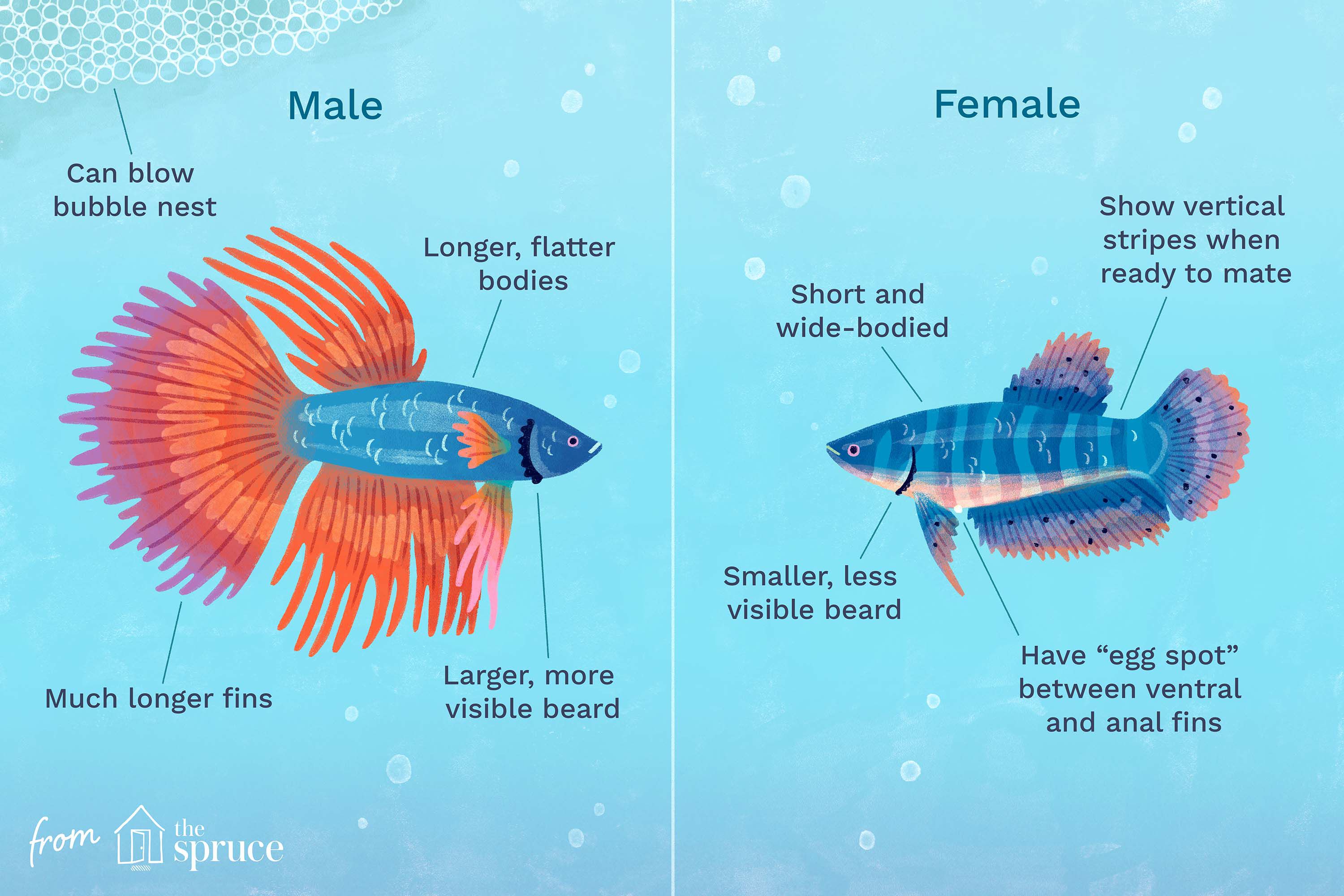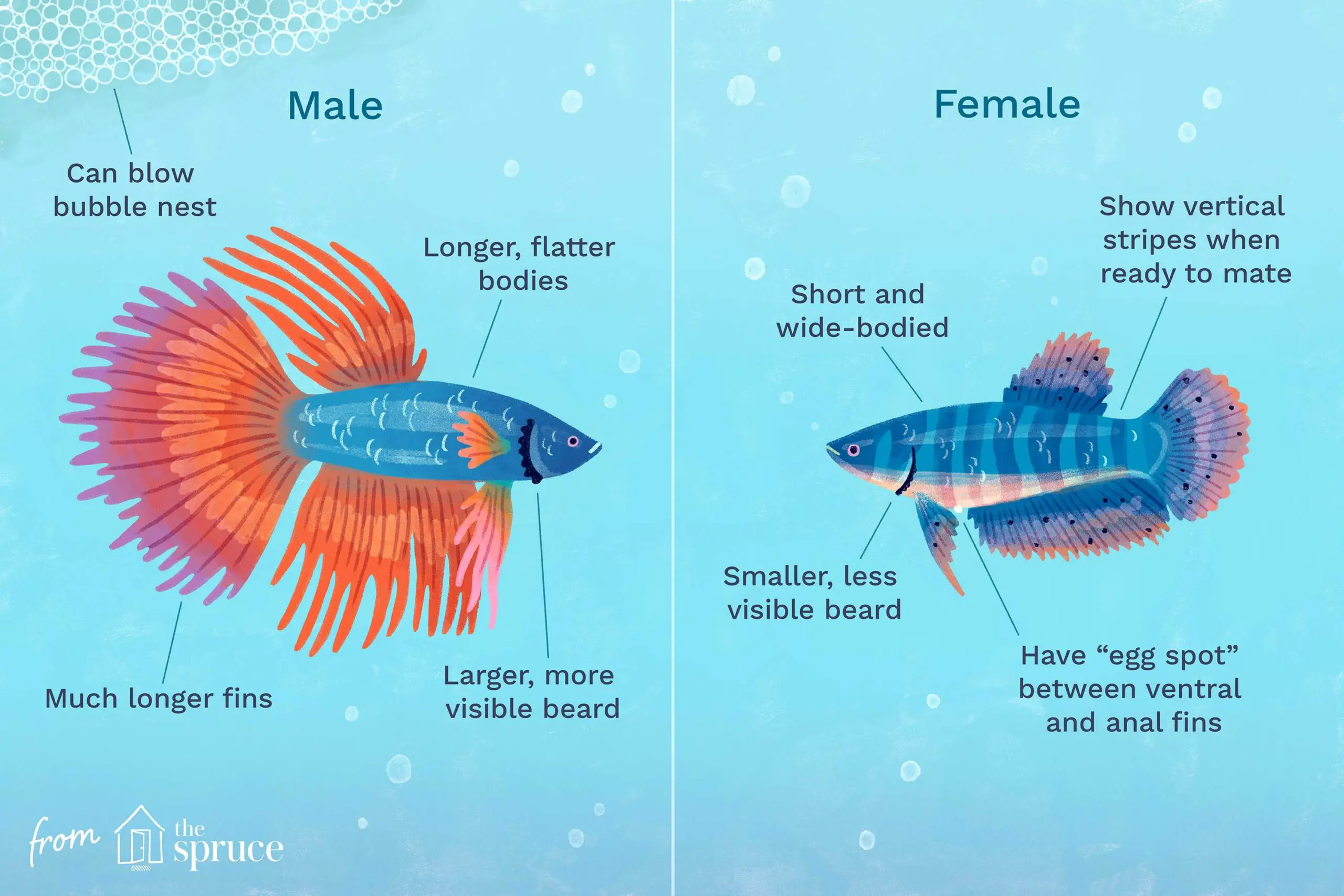Are you new to the world of betta fish and struggling to differentiate between a male and a female? Don’t worry, you’re not alone! Many first-time betta owners find it challenging to tell the difference between the two sexes. However, with the right knowledge and a little bit of practice, you can easily distinguish between a male and a female betta fish.
Male and female bettas have distinctive physical characteristics that set them apart. In this article, we’ll be discussing the key differences between the two sexes, such as body shape, fin size, and coloration. By the end of this guide, you’ll be able to confidently identify whether your betta is a male or a female. So let’s dive in and discover the fascinating world of betta fish!
If you want to determine the sex of a betta fish, there are a few things to look for. Males usually have longer, flowing fins and brighter colors, while females have shorter fins and more subdued colors. Additionally, males have a more pointed ventral fin, called a gonopodium, while females have a rounder ventral fin. You can also look at the shape of the fish’s body – males tend to be slimmer and more streamlined, while females have a rounder belly. By examining these physical characteristics, you can easily tell a male from a female betta fish.

How to Tell a Male From a Female Betta Fish?
If you’re a betta fish owner, then you might have found yourself wondering whether your fish is male or female. It’s important to know the sex of your betta fish as it can determine their behavior, compatibility with other fish, and breeding potential. In this article, we’ll look at how to tell a male from a female betta fish.
1. Body Shape
The body shape of a betta fish can give you clues about their sex. Male bettas tend to have a more streamlined and elongated body shape, while female bettas are typically rounder and wider. Males also have a more pointed anal fin, which is used to deposit sperm during mating.
Female bettas, on the other hand, have a shorter and wider anal fin that is used to release eggs. In addition, male bettas have longer and more flowing fins than females, making them a popular choice for aquarists who want a visually stunning fish.
To determine the body shape of your betta fish, observe it from different angles and compare it to pictures of male and female bettas.
2. Coloration
While coloration alone isn’t a reliable indicator of sex, there are some differences between male and female bettas. Male bettas are known for their vibrant and striking colors, which are used to attract females during mating.
In contrast, female bettas tend to have more subdued colors, with less vibrant and bright hues. However, there are some exceptions to this rule, and some female bettas can be just as colorful as males.
To determine the sex of your betta fish based on coloration, observe their colors and compare them to pictures of male and female bettas.
3. Fins
The fins of a betta fish can provide valuable clues about their sex. Male bettas have longer, flowing fins that are used to intimidate rivals and attract mates.
In contrast, female bettas have shorter fins that are less showy and more functional. However, there are some exceptions to this rule, and some female bettas can have long and flowing fins.
To determine the sex of your betta fish based on their fins, observe their size, shape, and length and compare them to pictures of male and female bettas.
4. Behavior
Male and female bettas have different behaviors that can indicate their sex. Male bettas tend to be more aggressive and territorial, especially towards other male bettas.
In contrast, female bettas are more social and less aggressive, making them more compatible with other fish in a community tank. However, female bettas can also be territorial and aggressive towards other females.
To determine the sex of your betta fish based on behavior, observe their interactions with other fish and their territorial behavior.
5. Bubble Nesting
Male bettas are known for their bubble nesting behavior, where they create a nest of bubbles on the surface of the water to attract females for mating.
Female bettas do not create bubble nests and are not involved in the mating process. However, some female bettas may display bubble nesting behavior when they are stressed or in poor water conditions.
To determine the sex of your betta fish based on bubble nesting behavior, observe their nesting behavior and compare it to pictures of male and female bettas.
6. Breeding Tube
The breeding tube is a small protrusion located near the vent of the fish, and it is used to release eggs or sperm during mating.
In male bettas, the breeding tube is longer and more pointed, while in female bettas, it is shorter and rounder. To observe the breeding tube, gently turn your betta fish over and look for the small protrusion near the vent.
To determine the sex of your betta fish based on the breeding tube, observe its length, shape, and location and compare it to pictures of male and female bettas.
7. Size
Male and female bettas have different sizes that can provide clues about their sex. Male bettas tend to be larger and longer than female bettas, with a more elongated body shape.
In contrast, female bettas are shorter and rounder, with a wider body shape. However, there are some exceptions to this rule, and some female bettas can be just as large as males.
To determine the sex of your betta fish based on size, observe their length, width, and overall body shape and compare it to pictures of male and female bettas.
8. Age
The age of a betta fish can also provide clues about their sex. Male bettas tend to mature and display breeding behavior at a younger age than females.
In contrast, female bettas generally mature later and are less likely to display breeding behavior until they are older. To determine the sex of your betta fish based on age, observe their behavior and compare it to the typical breeding age for male and female bettas.
9. Benefits of Knowing the Sex of Your Betta Fish
Knowing the sex of your betta fish can have several benefits for their care and well-being. For example, if you have a male betta, you may want to consider keeping them in a separate tank to avoid aggression towards other male bettas.
If you have a female betta, you may want to consider adding other fish to the tank to create a community tank. In addition, knowing the sex of your betta fish can help you determine their breeding potential and plan accordingly.
10. Male vs. Female Betta Fish
Overall, male and female bettas have different physical characteristics, behaviors, and care requirements. Male bettas are generally more colorful, aggressive, and territorial, while female bettas are more social and less aggressive.
When choosing a betta fish for your tank, consider their sex and how it will impact their care and compatibility with other fish. Whether you choose a male or female betta, they are sure to provide beauty and entertainment to your aquarium.
Frequently Asked Questions
Betta fish are popular pets due to their vibrant colors and unique personalities. However, many people struggle to identify the gender of their betta fish. Here are some common questions and answers to help you determine if your betta fish is male or female.
How can you tell if a betta fish is male or female?
The easiest way to determine the gender of a betta fish is by looking at its fins. Male betta fish have longer, flowing fins, while female betta fish have shorter, rounded fins. Males also tend to be larger and more brightly colored than females. Additionally, male betta fish have a more pointed body shape, while females have a rounder, more plump body.
Another way to tell if a betta fish is male or female is by observing its behavior. Male betta fish are typically more aggressive and territorial, while females are more docile and less likely to flare their fins. Males will often build bubble nests in their aquariums, while females will not.
Can betta fish change gender?
While it is extremely rare, betta fish have been known to change gender. This can occur when there is a lack of available mates of one gender, or when a male betta fish is removed from a group of females and placed in a separate tank. In these cases, the male betta fish may begin to develop female characteristics and eventually become female.
It is important to note that gender changes are very rare and should not be expected. It is also important to keep betta fish in appropriate tank sizes and with proper care to prevent stress and other health issues that could lead to gender changes.
Are male or female betta fish better for beginners?
Both male and female betta fish can make great pets for beginners. However, there are some differences to consider. Male betta fish are typically more active and have more vibrant colors, which can make them more visually appealing. However, they can also be more aggressive and territorial, which can make them more difficult to care for. Female betta fish are generally less aggressive and easier to care for, but they may be less visually striking.
Ultimately, the decision between a male or female betta fish comes down to personal preference and the individual fish’s temperament. It is important to research and understand the care requirements for betta fish before making a decision.
Do male and female betta fish need different tank setups?
Male and female betta fish have similar care requirements and do not typically require different tank setups. However, male betta fish may require more hiding spaces and plants to establish territories and prevent aggression towards other fish. Female betta fish may also do better in groups of three or more, while males are typically best kept alone.
It is important to provide a clean and appropriately sized tank for your betta fish, with proper filtration, heating, and water conditions. Consult with a veterinarian or experienced fish keeper for specific recommendations for your betta fish.
Can male and female betta fish live together?
Male and female betta fish should not be kept together, as they are likely to fight and injure each other. Male betta fish are particularly aggressive towards other males and may even attack females. If you want to keep multiple betta fish in the same tank, consider setting up a divided tank or keeping a group of female betta fish together.
It is important to research and understand the social dynamics of betta fish before attempting to keep them together. Always provide each fish with plenty of space and hiding places to reduce aggression and stress.

How to identify MALE and FEMALE betta Fish ” Female betta fish make bubble nests”
In conclusion, identifying the gender of a betta fish can be a bit tricky, but with the right knowledge and techniques, it can be done easily. Remember that the easiest and most reliable way to determine the sex of a betta fish is by looking at their fins. Males have longer, flowing fins, while females have shorter, rounder fins. It’s important to note that some betta fish may have characteristics of both genders, so don’t be discouraged if you encounter one that is difficult to identify. With practice and patience, you’ll be able to distinguish male from female betta fish like a pro.
If you’re interested in breeding betta fish, it’s important to be able to tell the difference between males and females. Breeding bettas is a complex and rewarding process, but it requires careful attention to detail. By learning how to identify the gender of a betta fish, you’ll be one step closer to becoming a successful betta breeder.
In addition to determining the gender of your betta fish, it’s important to provide them with the proper care and environment. Betta fish are territorial creatures that require clean water and a suitable living space. By providing your betta with the right conditions, you’ll ensure that they thrive and live a long, healthy life.

